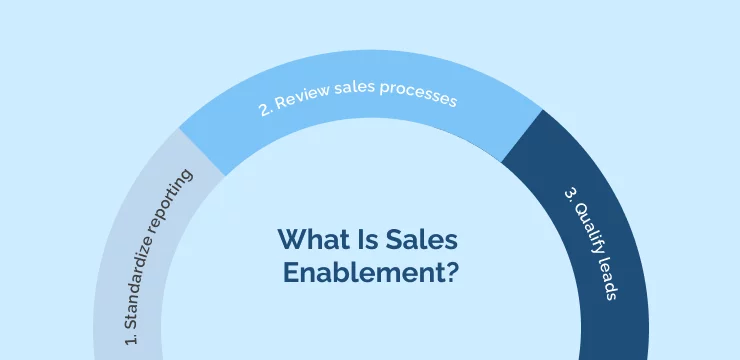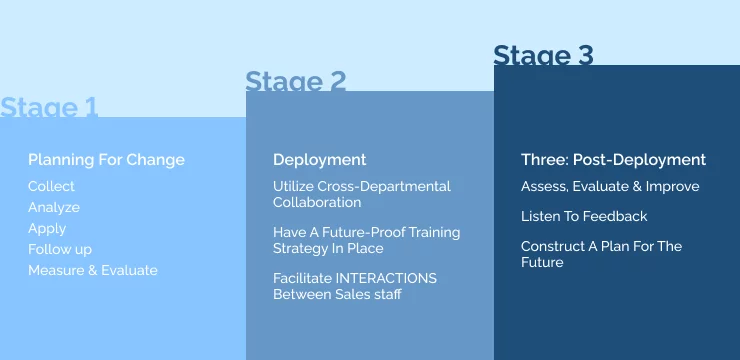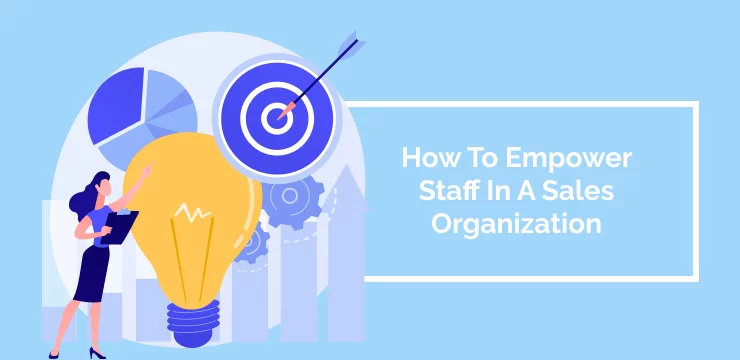
Sales. Revenue. Leads. Companies depend on the success of salespeople, which is why the public often views sales departments as one of the highest-stress environments within a company. And for a good reason. Sales reps are highly specialized staff under massive stress caused by the need for quota attainment, with tensions increasing each year as competition expands and the call for more revenue ramps up.
When change leaders throw the uncertainty and discomfort of a drastic transformation strategy into this mix, it can seem like a sadistic act upon sales employees’ heads. But resistance to change is never intended as an added challenge; it can be more of a bonus.
Change is there to help drive profits through sales efficiency. But effective change management can also support every staff member within sales departments to fulfill their roles more quickly. Change can also help avoid the dreaded low quota and, once new change processes become embedded, do sales tasks more efficiently.
Above all, sales teams need to feel understood, listened to, and incentivized to engage with change, and communication is key to this. But what are the best ways to incentivize change engagement for sales teams? How is sales enablement technology used? And what can be done to save salespeople time in focusing on the most promising leads? By answering these questions, we can obtain a clearer view of what makes sales staff tick and best practices for supporting them to accept and value change.
How Can Sales Teams Benefit From Change Management?

Communication and relationships are key to sales employees understanding the benefits of change management processes within their organization, leading them to buy in to change. Sales managers can easily express the advantages of change management when these elements are in place. Sales teams will then find meaningful benefits and use the information to practice each new process within an adoption or transformation strategy.
The main benefits of change management to sales teams are:-
- Staff can assess and understand the need and the impact of change.
- Business resources are aligned to support change.
- Staff can manage the diverse cost of change.
- Less time is needed to implement change when staff supports it.
In these ways, sales managers show sales staff the benefits of the change management process and how it leads to a new system. Once sales staff are on board with change, the change management process becomes more streamlined and happens much more quickly. Next, we will look at sales teams’ tools to carry out their duties and how this relates to change.
What Is Sales Enablement?

When you need someone to do something, you give them the best tools to do the job. In the same way, sales enablement is the key process that gives sales reps the tools and resources they need. Many organizations use sales enablement to help sales reps fulfill their role of boosting leads and working more customers through the buyer’s journey. Sales enablement has seven steps, and the first is to standardize reporting.
1. Standardize reporting
Standardizing reporting is the best way to get the most out of sales data. It is a means of agreeing on specific standards for reports so that they are all completed using the same methods on new software. Different companies do this in different ways, but some of the most popular forms of standardizing reporting are:-
- Sales team logs activities.
- Demos for products are delivered.
- Deal successes and failures.
- Generated/ worked leads.
Sales enablement professionals close the gap between reports and the sales leadership team, as sales leaders do not always receive technical reports training.
2. Review sales processes
Sales leadership should address gaps in sales processes, but this is often not the case. One example is if salespeople give many demos, but few lead to sales. In such an instance, the demo process should be examined and reviewed.
This shortfall is where a detailed sales process audit supported by data is needed, highlighting areas to improve. Most third-party sales enablement consultants include process audits as the first part of their assessment of a new business.
3. Qualify leads
Salespeople often have far too much information thrown at them by systems that aren’t related to suitable leads. Qualifying leads is essential to save time in this process.
Salespeople can use lead scoring systems to record whether a not a lead is suitable for the business and worthy of pursuit. Staff can also use CRM (Customer Relationship Management) software to find the right leads via fitting relevant companies and customers within them, filtering the suitable leads to be engaged immediately. The less relevant leads can be sent to a list for the sales team to engage.
Here we can see the value of high-quality sales data reporting and how this is essential to making the best use of time by salespeople. But how does this all relate to change management?
How Does Sales Enablement Interact With Change Management?

Gartner reports that “Customers are already 57% down the purchase path before they consider engaging with you.”
Sales links directly to change management as sales drive a company. This link is why the sales department often becomes the area of focus for innovation and transformation strategies. Knowing up-to-date statistics on potential leads helps to sort them into the most efficient categories, allowing the specialized sales employees to optimize their time and refine best practices to ensure the maximum amount of sales extracted from leads.
Sales enablement is also the key to change management in sales. The statistics provided by sales enablement specialists provide detail, and the consultation with sales enablement staff gives structure to plan how to make the best of leads and other sales areas.
Sales enablement specialists offer technology allowing sales staff to prepare and practice sales patter in a safe environment, such as machine learning and artificial intelligence being used to simulate customer interactions. Complex algorithms can also assist in coaching new and existing staff to speed up the rate at which salespeople make a sale.
However, sales staff must use technology as part of a holistic approach to sales enablement as a means of change management. Software and staff must monitor adoption rates and seller productivity to justify sales enablement budgets. Now that we have explored the link between sales enablement and change management, let’s look at the three stages of change management in a sales environment.
The 3 Stages Of Change Management In Sales

Change management is an integral part of any sales team, much like high-quality training and the best available and most appropriate technology. Gartner suggests that the Challenger Sale established a decade ago is the answer to ensuring staff are best prepared to increase sales via business-to-business (B2B) buyer behaviors. This example is relevant for B2B, But how do we conclude what change solutions sales staff need, and how do we avoid making change initiatives fail?
Using a three-step process, we can plan, deploy and engage in post-deployment to ensure we are doing everything possible to prepare for the upcoming changes. This process increases the likelihood that a transformation plan within a sales department will lead to successful change management.
Stage One: Planning For Change
Like any successful operation, planning is vital to ensure change leaders leave nothing out through thorough preparation, accounting for every eventuality. Once change leaders have carried out the planning in a detailed, structured way, the other processes fall into place. To begin planning organizational change, create a cut-off period for when the change will start.
Have A CUT-OFF Period For Change
A timeline needs to be drawn up, including a date for when change needs to begin. This timeline can allow senior staff to receive training and budget funds prepared by change leaders and senior staff to train team members for the incoming changes. Any specialist change consultants must also be contacted and scheduled for visits within this period. Senior staff must complete training before the cut-off.
The cut-off time for change is essential for employees who may feel unsure and hesitant about adopting change. For those who may not feel ready for change, the time before cut-off allows them to mentally prepare for the coming changes, ask questions and be convinced that they should get on board with the change management plan. Senior staff can also answer any questions about future training programs at this stage.
Listen To the sales team & Establish A Feedback Loop.
Listening is one of the critical elements of ensuring a successful change management plan. Change leadership needs to seek staff views and action these views to foster a culture of listening and being heard. This action will also positively influence customer satisfaction and service improvements given by sales staff, as sales team leadership models listening and actioning skills.
Establishing a feedback loop is part of efficiently using the information communicated with staff to action and change the processes of operations and services. Successfully Achieving this process involves four steps:-
Step one:
Collect staff feedback and use social media, online chat options, and surveys.
Step two:
Analyze data. Data collection tools often have analysis features.
Step three:
Apply feedback, initiative tests and update, experiment, review
Step four:
Follow up with staff. Ensure staff are aware of changes and happy and automate change updates if pushed for time
Following this plan, feedback can be collected and utilized to improve company processes and ensure a listening culture. In addition, sales staff will give feedback honestly and proactively in the future, ensuring staff is on board with all change initiatives. If not, they will be more likely to feel confident specifying why creating a dialogue between staff and management.
Measure & Evaluate
It is essential to create metrics as part of the plan to give an idea of what is needed and what form changes need to take. Change leaders use many tools to measure current company status in different departments, and this data can be recorded and contrasted with new metrics when change begins.
Stage Two: Deployment
Deployment is where chaos can occur within a change initiative. It is essential to ensure all staff in the sales organization, especially senior staff, are prepared before deployment occurs. The sales team establishes their opinions on the changes at this stage, making this a delicate time. Senior staff must be ready to support any distress caused within the organization.
Utilize Cross-Departmental Collaboration
Communicating between departments within an organization is crucial to share successes and failures within the change initiative. Team members will be sharing views on changes, and senior staff should also liaise across departments to monitor how the staff is receiving the changes. With everyone communicating inter-departmentally, collaboration should become a natural part of a robust change management deployment.
Have A Future-Proof Training Strategy In Place
Technology is often at the forefront of any change management initiative, but the technology used by an organization becomes obsolete over time. Planning for future success involves trying to anticipate and budget for today and tomorrow and all the challenges this may bring. Training staff for the future allows them to prepare as far as possible for challenges they will face, increasing resilience and coping strategies.
Facilitate INTERACTIONS Between Sales staff
As part of the department collaboration, senior staff will learn to encourage dialogues between staff. Sales management can use this within individual departments to host small meetings and events to speak about views regarding changes in a comfortable, open environment.
The act of being encouraged to air views, thoughts, and grievances about changes will make staff more likely to engage with the changes. It is human psychology to want to do what we are told not to, but when we are allowed to do something, resistance reduces, and we become more amenable to transition periods.
Stage Three: Post-Deployment
This stage is where the change agents must ensure that changes become embedded and part of the new status quo. The risk is that slowly the recent changes can dissolve over time, as staff realizes nobody is monitoring the new behaviors and values of the transformation plan. This risk is why change leaders must follow this method to ensure changes stick.
Assess, Evaluate & Improve
Assessment and evaluation ensure that the results of the change plan match up with the intentions. Sales managers can achieve these actions using metrics tools to collect data on the current performance of individuals and departments and customer satisfaction. Managers can then use these data to improve and build on each sales process, focusing on the team using new technology and training to enhance performance and employee experience.
Listen To Feedback
Once again, feedback from customers and staff needs to be visibly collected by organizations, listened to, and actioned for staff and customers to feel valued. Sales organizations can only stay competitive if these changes are acted upon as an ongoing process of analysis and implementing improvements.
Construct A Plan For The Future
The truth is that change agents can never sleep because once transformation plans have begun, they never stop. Strategies for change lead to methods for change because this is the current climate dictated by uncertainty and never-ending technological progress.
A more optimistic view to take on this is that every change plan helps safeguard against the competition. And with business leaders speaking about change so often, embracing it gives some reassurance that a company is on the right track. A plan for the future does not need to be as comprehensive as the initial change plan but needs to use what is learned for the short term to structure a plan of ongoing progress.
How To Empower Staff In A Sales Organization

Plans need to be structured, and metrics and feedback need to be collected. For this to happen, data needs to be analyzed and actioned, but where are the staff in all this? The team forms the heart of change, and sales staff are incredibly skilled but pressured to perform to a certain standard, even before change adoption occurs.
Sales success occurs within full adoption, as the sales team engages with change, living and breathing all the transitional new processes. Amongst all the necessity of processes and data, leadership needs to focus on staff to avoid them becoming lost in the entire process and to ensure they benefit. Communication between salespeople, managers, and change agents must be encouraged at all stages, and leadership training is one of the key elements to address this.
When this has all occurred, salespeople utilize new processes to their optimal level. They will also be prepared for change as it becomes part of their values. They buy in to change, seeing that it involves not just company benefits but also the personal gain of making their job easier. This embodying of change increases completed sales, productivity, and revenue, optimizing job satisfaction as sales successes increase.
WalkMe Team
WalkMe spearheaded the Digital Adoption Platform (DAP) for associations to use the maximum capacity of their advanced resources. Utilizing man-made consciousness, AI, and context-oriented direction, WalkMe adds a powerful UI layer to raise the computerized proficiency, everything being equal.



